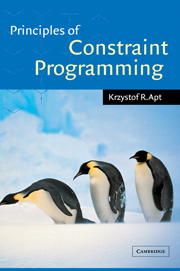Book contents
- Frontmatter
- Contents
- Acknowledgements
- 1 Introduction
- 2 Constraint satisfaction problems: examples
- 3 Constraint programming in a nutshell
- 4 Some complete constraint solvers
- 5 Local consistency notions
- 6 Some incomplete constraint solvers
- 7 Constraint propagation algorithms
- 8 Search
- 9 Issues in constraint programming
- Bibliography
- Author index
- Subject index
1 - Introduction
Published online by Cambridge University Press: 15 December 2009
- Frontmatter
- Contents
- Acknowledgements
- 1 Introduction
- 2 Constraint satisfaction problems: examples
- 3 Constraint programming in a nutshell
- 4 Some complete constraint solvers
- 5 Local consistency notions
- 6 Some incomplete constraint solvers
- 7 Constraint propagation algorithms
- 8 Search
- 9 Issues in constraint programming
- Bibliography
- Author index
- Subject index
Summary
Basic characteristics of constraint programming
THIS BOOK IS about constraint programming, an alternative approach to programming which relies on a combination of techniques that deal with reasoning and computing. It has been successfully applied in a number of fields including molecular biology, electrical engineering, operations research and numerical analysis. The central notion is that of a constraint. Informally, a constraint on a sequence of variables is a relation on their domains. It can be viewed as a requirement that states which combinations of values from the variable domains are admitted. In turn, a constraint satisfaction problem consists of a finite set of constraints, each on a subsequence of a given sequence of variables.
To solve a given problem by means of constraint programming we first formulate it as a constraint satisfaction problem. To this end we
introduce some variables ranging over specific domains and constraints over these variables;
choose some language in which the constraints are expressed (usually a small subset of first-order logic).
This part of the problem solving is called modeling. In general, more than one representation of a problem as a constraint satisfaction problem exists. Then to solve the chosen representation we use either
domain specific methods,
or
general methods,
or a combination of both.
The domain specific methods are usually provided in the form of implementations special purpose algorithms.
Information
- Type
- Chapter
- Information
- Principles of Constraint Programming , pp. 1 - 7Publisher: Cambridge University PressPrint publication year: 2003
Accessibility standard: Unknown
Why this information is here
This section outlines the accessibility features of this content - including support for screen readers, full keyboard navigation and high-contrast display options. This may not be relevant for you.Accessibility Information
- 1
- Cited by
